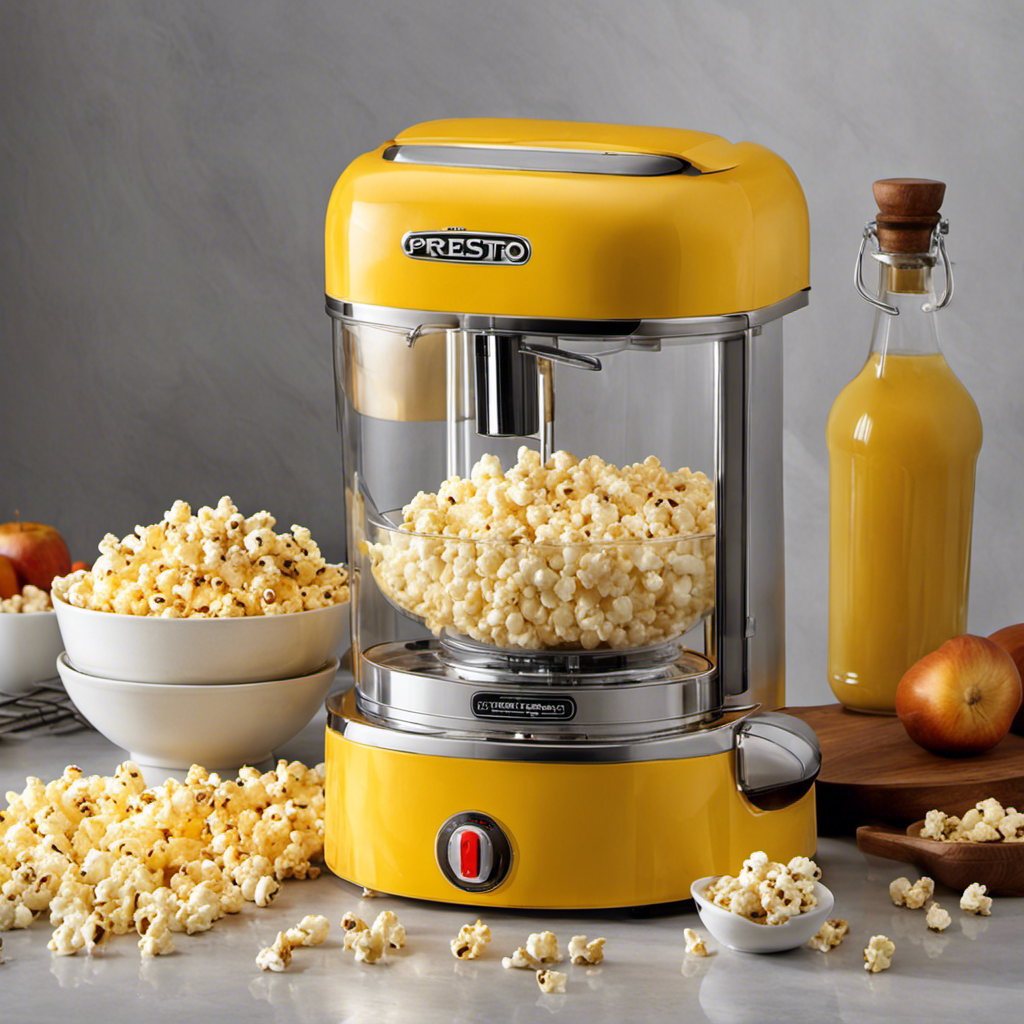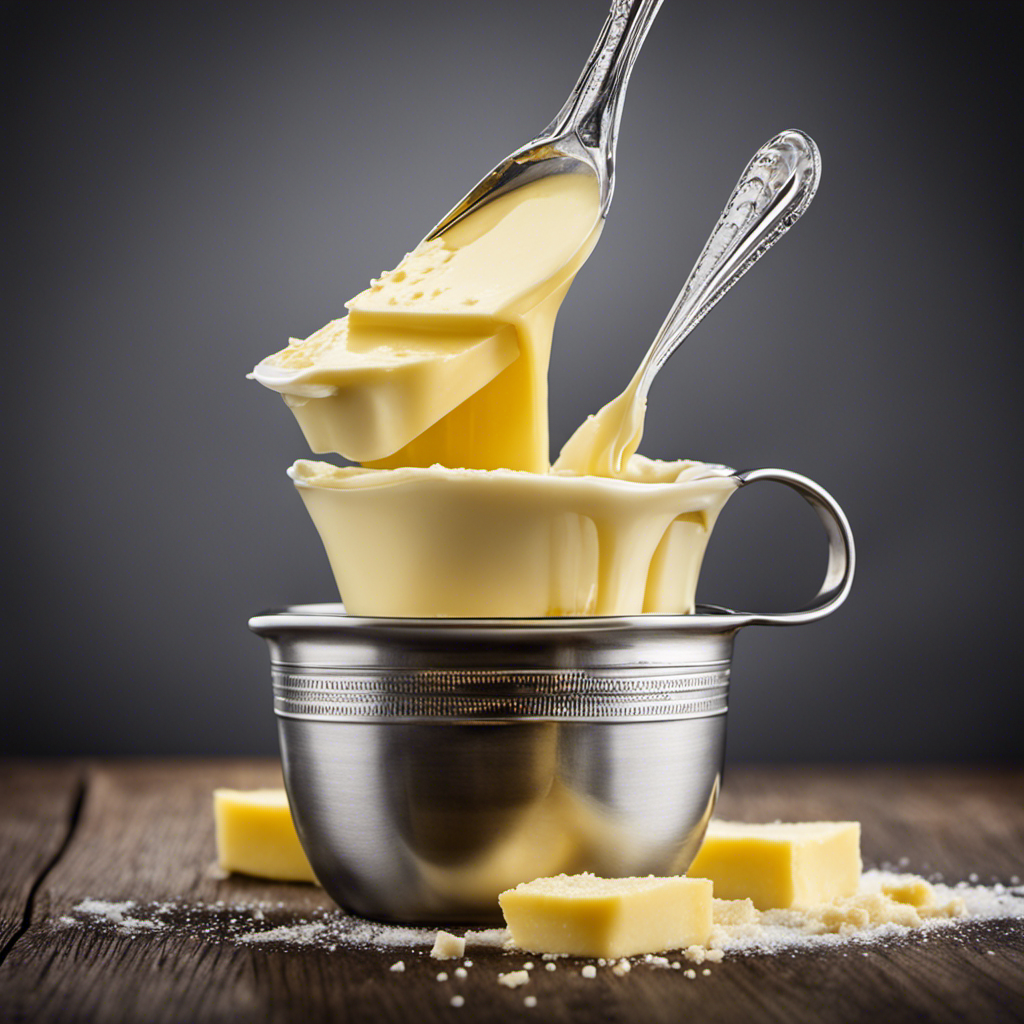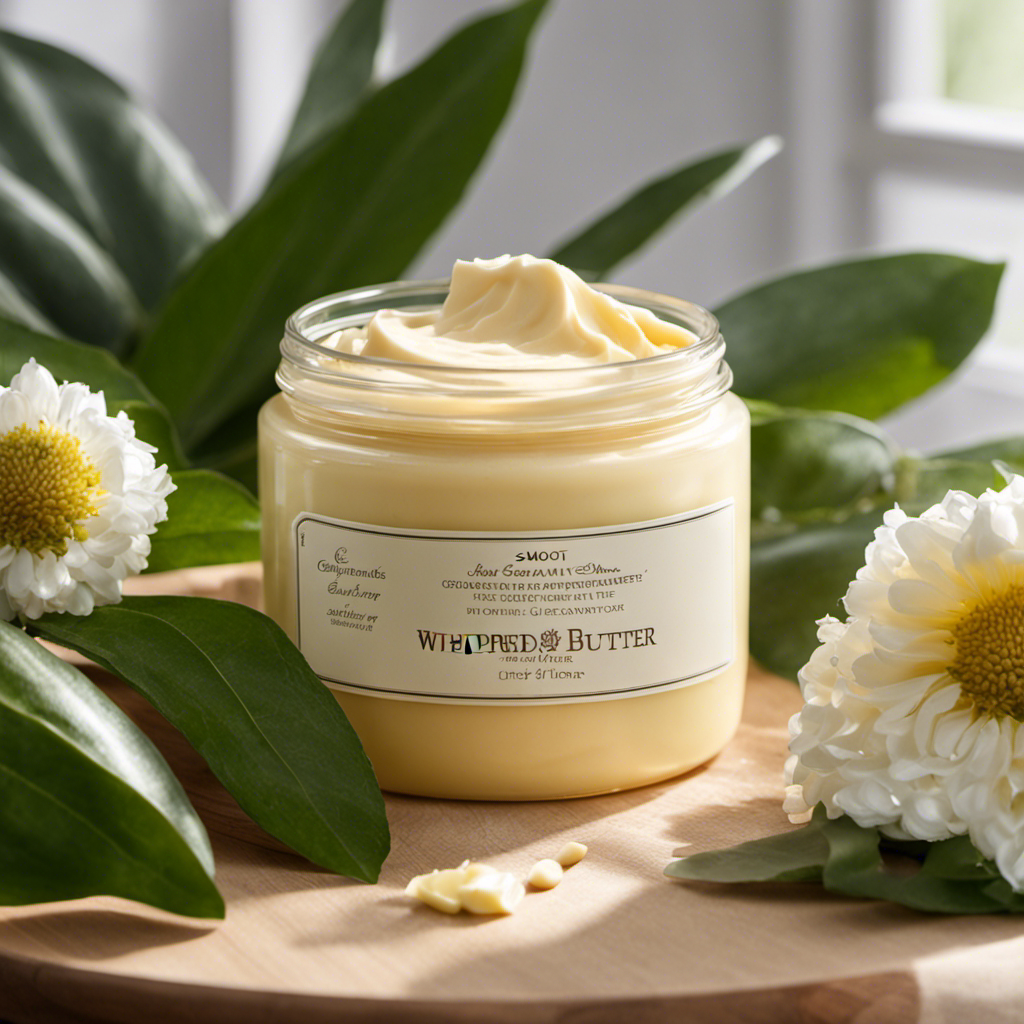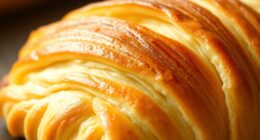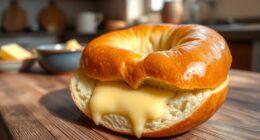Here I stand, poised to explore the fantastic realm of popcorn creation using the Butter Presto Fountain Popcorn Maker. The moment has come to replicate the cinema experience within the comfort of my home. With this convenient device, I can indulge in tasty, butter-laden popcorn at my whim.
In this article, I’ll guide you through the process of adding butter to your popcorn using the Presto Fountain Popcorn Maker. Get ready to elevate your popcorn game to a whole new level!
Key Takeaways
- The butter melting tray is used to melt butter and distribute it onto the popcorn.
- Adjust the amount of popcorn kernels or heat setting if the popcorn doesn’t pop evenly.
- Regularly remove and clean the kettle after each use.
- Experiment with different butter flavors to enhance the popcorn experience.
Unboxing the Butter Presto Fountain Popcorn Maker
I’m going to start unboxing the Butter Presto Fountain Popcorn Maker. As I open the box, I find the popcorn maker securely packed and protected. The first thing I notice is the sleek design and compact size of the machine. It’s lightweight, making it easy to move around and store.
The unboxing process is straightforward and simple. Inside the box, I find the main unit, a stir rod, a measuring cup, and a user manual.
To set up the popcorn maker, I follow the instructions provided in the user manual. I plug in the machine and place it on a flat surface. Next, I attach the stir rod to the motor and ensure it is properly secured. Then, I add the desired amount of popcorn kernels and close the lid.
The Butter Presto Fountain Popcorn Maker features a built-in butter melter that can be used to add a delicious buttery flavor to the popcorn. Simply add butter to the melting tray, and it will melt and drizzle onto the popcorn as it pops.
In case you encounter any setup issues, here are some common troubleshooting tips. Firstly, ensure that the power cord is securely plugged into a functioning outlet. If the machine doesn’t turn on, check the power switch and make sure it is in the ‘on’ position. Additionally, make sure the stir rod is properly attached to the motor and that the lid is securely closed. If the popcorn doesn’t pop evenly, try adjusting the amount of kernels or the heat setting.
Checking the Components of the Popcorn Maker
Before we dive into the assembly process of the Butter Presto Fountain Popcorn Maker, it’s essential to identify all the necessary components. This will ensure a smooth and hassle-free assembly experience.
Once the components are identified, we’ll clarify the assembly instructions step by step to avoid any confusion or misinterpretations.
Additionally, we’ll address common troubleshooting issues that may arise during the assembly process, providing solutions to help you overcome any challenges and enjoy your popcorn maker to the fullest.
Necessary Components Identified
To get started with your butter presto fountain popcorn maker, make sure you have all the necessary components identified. Here are the three essential components you will need for assembly:
-
Popcorn Maker Base: This is the main body of the popcorn maker where all the magic happens. It houses the heating element and the motor that powers the popcorn popping and butter melting processes.
-
Popcorn Bowl: This is where the freshly popped popcorn will collect. It is designed to be wide enough to catch all the popped kernels and allow for easy serving.
-
Butter Melting Tray: This tray is specifically designed to melt butter and allow it to flow down the fountain-like structure of the popcorn maker, ensuring even distribution and delicious buttery goodness on your popcorn.
Now that you have identified all the necessary components, you are ready to move on to the assembly instructions and butter melting techniques.
Assembly Instructions Clarified
Once you have all the necessary components identified, it’s time to clarify the assembly instructions for your butter presto fountain popcorn maker. Assembly troubleshooting can be frustrating, but with the right instructions, it can be a breeze. To help you understand the process better, I have prepared a table below that outlines the step-by-step instructions for assembling your popcorn maker:
| Step | Instructions |
|---|---|
| 1 | Place the base of the popcorn maker on a flat surface. |
| 2 | Attach the butter melting tray to the top of the base. |
| 3 | Insert the popcorn popping chamber onto the base, aligning the tabs. |
| 4 | Connect the motor assembly to the popping chamber. |
| 5 | Finally, attach the butter warming tray to the top of the motor assembly. |
Now that you have a clear understanding of the assembly process, let’s move on to discussing butter melting techniques.
Troubleshooting Common Issues
If you’re experiencing any issues during assembly, troubleshooting can help solve common problems. Here are some steps you can take to troubleshoot the most common issues with the Presto Fountain Popcorn Maker:
-
Check the butter temperature: If your butter is too cold or too hot, it can cause issues with the machine. Make sure the butter is at room temperature before adding it to the popcorn maker.
-
Listen for popping sound issues: If you notice that the popping sound is inconsistent or if there are no pops at all, it could be due to a clog in the machine. Check the popcorn chute and remove any obstructions that may be blocking the flow of kernels.
-
Clean the machine regularly: Over time, oil and residue can build up in the popcorn maker, affecting its performance. Clean the machine thoroughly after each use to prevent any issues.
Preparing the Popcorn Kernels for Use
First, make sure you’ve correctly measured the popcorn kernels before adding them to the Presto Fountain popcorn maker. It’s essential to have the right amount of kernels to ensure a perfect batch of popcorn.
Once you’ve measured the kernels, it’s time to think about the toppings. While butter is a classic choice, there are also alternatives for those who prefer a different flavor or want to make a healthier choice.
One popular butter alternative is clarified butter, also known as ghee. It has a rich, nutty taste and adds a delicious flavor to the popcorn. Another option is coconut oil, which imparts a slightly sweet taste and is a great choice for those who are dairy-free. For a more savory option, you can try using olive oil or avocado oil. These oils add a unique flavor profile to the popcorn and are healthier options compared to butter.
In addition to butter alternatives, there are also various popcorn seasoning options available. You can experiment with different flavors like cheese, caramel, or even spicy seasonings. Some popular choices include cheddar cheese powder, cinnamon sugar, or ranch seasoning. These seasonings can be added to the popcorn after it’s popped or mixed with the butter alternative before pouring it over the kernels.
Overall, the Presto Fountain popcorn maker allows you to customize your popcorn experience by offering a range of butter alternatives and popcorn seasoning options. Whether you prefer a classic buttery taste or want to try something different, this popcorn maker has got you covered.
Adding Oil to the Popcorn Maker
To achieve the perfect flavor and texture, make sure you’ve evenly coated the kernels with oil before popping them in the popcorn maker. The oil is essential in ensuring that the kernels pop evenly and don’t stick together.
When it comes to adding oil to your popcorn maker, there are a few things to keep in mind.
-
Oil Quantity: It’s important to use the right amount of oil to avoid soggy or greasy popcorn. Generally, you’ll want to use about 1 to 2 tablespoons of oil for every 1/4 cup of popcorn kernels. This ratio ensures that the kernels are coated evenly without being overwhelmed by oil.
-
Different Types of Oil: While most people opt for vegetable or canola oil, there are other options to consider. Coconut oil, for example, can add a unique flavor to your popcorn. Olive oil is another popular choice, especially for those looking for a healthier alternative. Experimenting with different oils can help you discover new and delicious flavors.
-
Oil Distribution: To ensure that the kernels are evenly coated, it’s important to distribute the oil evenly. One way to do this is by adding the oil to the popcorn maker before the kernels. This allows the oil to heat up and spread throughout the machine, ensuring that every kernel gets its fair share of oil.
Setting up the Popcorn Maker
When it comes to setting up a popcorn maker, it’s important to follow the assembly instructions carefully to ensure proper functionality.
In this discussion, I will provide step-by-step guidance on how to assemble the popcorn maker correctly.
Additionally, I will address some common setup issues that users may encounter and offer troubleshooting tips to resolve them effectively.
Assembly Instructions for Popcorn Maker
Before you start assembling the popcorn maker, make sure you have all the necessary parts and tools ready. This will ensure a smooth and hassle-free setup process. Here are some tips for easy popcorn maker assembly:
-
Follow the instruction manual: The manual provides step-by-step guidance on how to assemble the popcorn maker. Make sure to read it thoroughly before beginning the assembly process.
-
Organize the parts: Lay out all the parts in front of you and ensure you have everything you need. This will help you avoid any missing or misplaced components during the assembly.
-
Take your time: Assembly may seem overwhelming at first, but take it one step at a time. Rushing through the process can lead to mistakes or missing steps.
Troubleshooting Common Setup Issues
If you encounter any issues during setup, don’t worry – troubleshooting common problems is easier than you think.
One common issue that may arise is trouble with the butter melting. To troubleshoot this, make sure that the butter is at room temperature before adding it to the popcorn maker. Cold butter can take longer to melt and may cause clogs in the system.
Another common problem is troubleshooting oil distribution. If you notice that the oil is not distributing evenly, try shaking the popcorn maker gently to ensure proper mixing. If the issue persists, you can also try adding a little more oil to the popcorn maker.
By following these troubleshooting steps, you can ensure a smooth setup process for your popcorn maker.
Now, let’s move on to the next step – turning on the popcorn maker.
Turning on the Popcorn Maker
To turn on the Popcorn Maker, simply press the power button.
Once the power is on, you may encounter some troubleshooting power issues. Here are a few tips to help you overcome them:
-
Check the power source: Ensure that the Popcorn Maker is plugged into a functioning power outlet. Sometimes, a loose connection or a faulty socket can cause power issues.
-
Reset the machine: If the Popcorn Maker is not turning on, try resetting it by unplugging it from the power source and plugging it back in after a few seconds. This can often resolve minor power-related problems.
-
Contact customer support: If you have tried the above steps and are still experiencing power issues, it may be best to reach out to the manufacturer’s customer support for further assistance.
Once you have successfully powered on the Popcorn Maker, you can move on to adjusting the heat settings. This is an important step to ensure that your popcorn is cooked to perfection.
Adjusting the Heat Settings
After successfully turning on the popcorn maker, the next step is to adjust the heat settings for optimal popcorn popping. The heat control feature allows you to regulate the temperature inside the machine, ensuring that the popcorn kernels are popped evenly and to your desired level of crispiness.
To adjust the heat settings, locate the temperature adjustment knob on the popcorn maker. This knob is usually located on the front or side of the machine and is labeled with temperature markers. Turn the knob clockwise to increase the heat and counterclockwise to decrease it.
It’s important to find the right balance of heat to avoid burning the popcorn or leaving it undercooked. Start with a medium heat setting and adjust accordingly based on your preferences and the manufacturer’s recommendations. Keep in mind that different popcorn brands and sizes may require slight adjustments to the heat settings.
Once you have adjusted the heat settings, you are ready to move on to the next step of adding butter to the popcorn maker. This step will enhance the flavor of your popcorn and make it even more delicious.
Adding Butter to the Popcorn Maker
When it comes to making popcorn, adding butter is a crucial step that can greatly enhance the flavor.
In this discussion, we will explore different techniques for melting butter, ensuring it spreads evenly over the popcorn.
Additionally, we will delve into finding the optimal quantity of butter to achieve that perfect balance between taste and texture.
Lastly, we’ll touch upon how experimenting with different butter flavor variations can elevate your popcorn experience to a whole new level.
Butter Melting Techniques
First, make sure you’ve melted the butter before adding it to the Presto Fountain Popcorn Maker. Melting the butter properly is essential to ensure that it mixes well with the popcorn and coats it evenly. Here are some techniques to achieve the perfect melted butter consistency:
- Use a microwave-safe bowl and cut the butter into smaller pieces to help it melt evenly.
- Heat the butter in short intervals, stirring in between, to prevent it from overheating or splattering.
- Keep an eye on the melting temperature to avoid burning the butter. The ideal temperature is around 120-130°F (49-54°C) for a smooth and pourable consistency.
By following these techniques, you can achieve the perfect melted butter for your popcorn.
Now, let’s move on to the next section to determine the optimal quantity of butter to add to the Presto Fountain Popcorn Maker.
Optimal Butter Quantity
When it comes to adding butter to your Presto Fountain Popcorn Maker, it’s important to use the optimal quantity for a delicious popcorn experience. The butter measurement can vary depending on personal preference, but a good rule of thumb is to use about 1-2 tablespoons of melted butter per 1/4 cup of popcorn kernels. This ratio ensures that the popcorn is evenly coated with a buttery flavor without becoming soggy.
To achieve the perfect butter measurement, you can use a kitchen scale to weigh the butter before melting it. Alternatively, you can use measuring spoons to accurately measure the desired amount.
As for butter melting techniques, there are a few options. One popular method is to melt the butter in a microwave-safe bowl in short intervals until it reaches a liquid state. Another method is to melt the butter in a small saucepan over low heat, stirring constantly to prevent burning. Whichever method you choose, make sure to let the melted butter cool slightly before pouring it over the popcorn to avoid making it soggy.
Butter Flavor Variations
To enhance the flavor of your popcorn, you can experiment with different variations of butter. Butter is a versatile ingredient that can be flavored in various ways to suit your taste preferences.
Here are some butter flavoring recipes that you can try:
- Garlic Butter: Mix melted butter with minced garlic for a savory and aromatic flavor.
- Herb Butter: Blend softened butter with chopped herbs like basil, parsley, or thyme for a fresh and earthy taste.
- Sweet Cinnamon Butter: Combine softened butter with cinnamon and a hint of sugar for a deliciously sweet and spicy flavor.
In addition to adding a burst of flavor to your popcorn, butter can also provide some health benefits. It contains essential fatty acids and fat-soluble vitamins that are important for brain function and maintaining healthy skin.
However, it’s important to consume butter in moderation as it is high in saturated fats. So go ahead and get creative with your butter flavorings, but remember to enjoy them in moderation for a healthier popcorn experience.
Using Flavored Butter With the Popcorn Maker
You can enhance the flavor of your popcorn by using flavored butter in the Presto Fountain Popcorn Maker. Adding different flavors to your butter can take your popcorn experience to a whole new level. Not only does it add a delicious twist to your favorite snack, but it also allows you to experiment with different flavors and create unique combinations. Here are some flavored butter recipes that you can try with your popcorn maker:
| Flavor | Ingredients | Instructions |
|---|---|---|
| Garlic Butter | 1/4 cup butter | Melt the butter and mix in minced garlic. Drizzle over popcorn. |
| Caramel Butter | 1/4 cup butter | Melt the butter and mix in caramel sauce. Drizzle over popcorn. |
| Parmesan Butter | 1/4 cup butter | Melt the butter and mix in grated parmesan cheese. Drizzle over popcorn. |
Using flavored butter not only adds taste but also brings some health benefits to your popcorn. Butter is a good source of fat-soluble vitamins like vitamin A, E, and K. It also contains healthy saturated fats that are essential for brain function and hormone production. However, it is important to consume flavored butter in moderation as it can be high in calories and saturated fat. To enjoy the health benefits of butter without overindulging, use flavored butter sparingly and balance it with a healthy diet. So go ahead, get creative with your flavored butter recipes and enjoy a flavorful and nutritious popcorn experience!
Mixing the Butter With the Popcorn
When it comes to mixing the butter with the popcorn, there are a few techniques and considerations to keep in mind. The goal is to achieve a perfect balance of buttery goodness without making the popcorn overly greasy. Here are some tips to help you get it just right:
-
Melt the butter properly: Start by melting the butter in a microwave-safe bowl or on the stovetop. Make sure to melt it completely and avoid any lumps or solid chunks.
-
Use the optimal butter quantity: The amount of butter you add to the popcorn can make a big difference in the taste and texture. It’s best to start with a smaller amount and gradually add more to suit your preference. Too little butter may result in bland popcorn, while too much can make it soggy.
-
Drizzle or toss the butter: Once the butter is melted, you can either drizzle it over the popcorn or toss the popcorn with the butter in a large bowl. Both methods work well, so choose the one that is most convenient for you.
Tips for Achieving a Perfect Buttery Popcorn
When it comes to making the perfect buttery popcorn, there are a few key techniques to keep in mind.
First, mastering the art of melting butter is crucial to achieve that delicious, even distribution of flavor. I will discuss different methods for melting butter and how each can affect the taste and texture of your popcorn.
Additionally, I will explore tips for evenly distributing seasonings on your popcorn to ensure every bite is bursting with flavor.
Butter Melting Techniques
To melt the butter for your popcorn, simply place it in a microwave-safe bowl and heat it in short intervals until it becomes smooth and liquid. The melting process is crucial to achieve that perfect buttery taste.
Here are some tips to ensure a successful melting process:
- Use unsalted butter for a cleaner and purer taste.
- Cut the butter into small cubes or slices to help it melt evenly and quickly.
- Check the butter temperature regularly to prevent it from overheating and becoming too runny or burnt.
Seasoning Distribution Tips
Now that we’ve learned about different techniques for melting butter in the Presto Fountain Popcorn Maker, let’s move on to the next step: seasoning distribution.
Once you have melted your butter, it’s time to add flavor to your popcorn. The Presto Fountain Popcorn Maker offers various options for seasoning your popcorn. You can choose from classic butter and salt, or get creative with different flavorings like cheese, caramel, or even spicy seasoning blends.
To ensure even distribution of the seasoning, I recommend adding it in layers. Start by pouring a small amount of popcorn into a bowl, then sprinkle your desired seasoning over the top. Toss the popcorn gently to coat it evenly, then repeat the process until all the popcorn is seasoned to your liking. This method guarantees that every bite will be bursting with flavor.
Now that we know how to season our popcorn, let’s move on to the next section: cleaning and maintaining the popcorn maker.
Cleaning and Maintaining the Popcorn Maker
Cleaning and maintaining the popcorn maker is essential for its longevity and optimal performance. Here are some cleaning instructions and maintenance tips to help you keep your popcorn maker in top shape:
-
Regularly remove and clean the kettle: The kettle is where the popcorn kernels are popped, so it’s important to clean it after each use. Simply wipe it down with a damp cloth or sponge and mild dish soap. Avoid using abrasive cleaners that could damage the surface.
-
Clean the glass panels and doors: The glass panels and doors of the popcorn maker can accumulate oil and grease over time. Use a glass cleaner or a mixture of vinegar and water to clean them. Make sure to dry them thoroughly to prevent streaks.
-
Clean the interior and exterior surfaces: Wipe down the interior and exterior surfaces of the popcorn maker with a damp cloth or sponge. If there are any stubborn stains, you can use a mild cleaner or vinegar solution. Again, make sure to dry everything thoroughly.
By following these cleaning instructions and maintenance tips, you can ensure that your popcorn maker remains in great condition for years to come.
Now, let’s move on to the next section about storing the butter presto fountain popcorn maker.
Storing the Butter Presto Fountain Popcorn Maker
When storing the Butter Presto Fountain Popcorn Maker, remember to unplug it and allow it to cool completely before moving or covering it. Storing your popcorn maker properly will help ensure its longevity and keep it in good working condition.
Firstly, make sure to clean the popcorn maker thoroughly before storing it. This will prevent any leftover popcorn kernels or butter from becoming stale or attracting pests. To clean the popcorn maker, wipe it down with a damp cloth and mild detergent. Avoid using harsh chemicals or abrasive materials that could damage the machine.
Once it is clean, allow it to air dry completely before storing it. Next, find a cool, dry place to store the popcorn maker. Avoid areas with high humidity, as this can cause rust or mold to develop. It is also important to protect the machine from dust and debris by covering it with a clean cloth or storing it in a protective case.
Troubleshooting Common Issues With the Popcorn Maker
If you’re experiencing any issues with your popcorn maker, try checking the power cord and ensuring it is securely plugged in. This is a common cause of problems and can easily be fixed by making sure the cord is connected properly.
However, if your popcorn maker is still not working properly, there may be other common issues that you can troubleshoot.
Here are some common popcorn maker problems and how to troubleshoot them:
-
Burnt popcorn: If your popcorn is coming out burnt, it could be due to a couple of reasons. First, make sure you are using the correct amount of oil and popcorn kernels. Too much oil or too many kernels can cause the popcorn to burn. Additionally, make sure you are using the correct heat setting on your popcorn maker. Adjusting the heat can help prevent burning.
-
Popcorn not popping: If your popcorn is not popping, it could be due to old or stale popcorn kernels. Try using fresh kernels and see if that solves the problem. Additionally, check the heat settings on your popcorn maker. If the heat is too low, the kernels may not pop properly.
-
Overheating: If your popcorn maker is overheating, it could be due to a clogged vent or a faulty thermostat. Check the vents for any blockages and clean them if necessary. If the problem persists, you may need to contact the manufacturer for further assistance.
Alternative Ways to Add Butter to Your Popcorn
To enhance the flavor of your popcorn, try using melted butter instead of the traditional method. When it comes to adding butter to your popcorn, there are alternative options that can elevate your snacking experience.
While the traditional method involves drizzling melted butter over the popcorn, there are other butter alternatives you can explore. One option is using flavored oils instead of butter. These oils come in a variety of flavors, such as truffle, garlic, or even chili. They can add a unique and delicious taste to your popcorn without the need for butter.
Another alternative is using nutritional yeast, which not only provides a cheesy flavor but also adds a boost of vitamins and minerals. For a healthier alternative, you can try using coconut oil. It not only gives your popcorn a rich and buttery taste but also offers numerous health benefits. Coconut oil is known for its high smoke point, making it a great option for popping corn kernels.
Frequently Asked Questions
Can I Use Pre-Packaged Popcorn Kernels With the Butter Presto Fountain Popcorn Maker?
Yes, you can use pre-packaged popcorn kernels with the Butter Presto Fountain Popcorn Maker. It’s a convenient option if you don’t want to prepare your own kernels. You can also experiment with alternative seasonings for different flavors.
How Long Does It Take for the Popcorn to Pop in the Popcorn Maker?
It typically takes around 3-4 minutes for the popcorn to fully pop in the Presto Fountain Popcorn Maker. This popcorn maker does not come with a timer, so you will need to keep an eye on it.
Can I Add Other Seasonings Besides Butter to the Popcorn?
Yes, you can definitely add other seasonings besides butter to your popcorn! There are so many delicious options to try, like garlic powder, cheese, or even caramel. Making homemade popcorn seasonings is a fun and creative way to enhance your popcorn experience.
What Is the Best Type of Oil to Use With the Popcorn Maker?
The best type of oil to use with the popcorn maker is coconut oil. It provides a delicious flavor and a nice crunch to the popcorn. However, if you’re looking for alternatives to butter, you can try using olive oil or even flavored oils like truffle oil.
How Do I Clean the Butter Presto Fountain Popcorn Maker?
To clean the Butter Presto Fountain Popcorn Maker, follow these cleaning tips for popcorn maker. First, unplug the machine and let it cool. Then, remove any leftover popcorn and wipe the surfaces with a damp cloth. Finally, dry thoroughly before storing.
Conclusion
In conclusion, adding butter to your popcorn has never been easier with the Butter Presto Fountain Popcorn Maker.
With its simple setup and easy maintenance, this popcorn maker is a must-have for popcorn enthusiasts.
Whether you’re hosting a movie night or just craving a delicious snack, this machine will deliver perfectly buttered popcorn every time.
So, why settle for plain popcorn when you can have a fountain of buttery goodness?
With the Butter Presto Fountain Popcorn Maker, your popcorn experience will reach new heights, making every movie night a memorable one.
